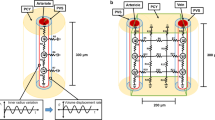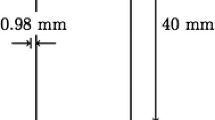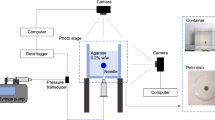Abstract
A nonlinear, coupled biphasic-mass transport model that includes transvascular fluid exchange is proposed for flow-controlled infusions in brain tissue. The model accounts for geometric and material nonlinearities, a hydraulic conductivity dependent on deformation, and transvascular fluid exchange according to Starling’s law. The governing equations were implemented in a custom-written code assuming spherical symmetry and using an updated Lagrangian finite-element algorithm. Results of the model indicate that, using normal physiological values of vascular permeability, transvascular fluid exchange has negligible effects on tissue deformation, fluid pressure, and transport of the infused agent. As vascular permeability may be increased artificially through methods such as administering nitric oxide, a parametric study was conducted to determine how increased vascular permeability affects flow-controlled infusion. Increased vascular permeability reduced both tissue deformation and fluid pressure, possibly reducing damage to tissue adjacent to the infusion catheter. Furthermore, the loss of fluid to the vasculature resulted in a significantly increased interstitial fluid concentration but a modestly increased tissue concentration. From a clinical point of view, this increase in concentration could be beneficial if limited to levels below which toxicity would not occur. However, the modestly increased tissue concentration may make the increase in interstitial fluid concentration difficult to assess in vivo using co-infused radiolabeled agents.
Similar content being viewed by others

References
Almeida, E. S., & Spilker, R. L. (1997). Mixed and penalty finite element models for the nonlinear behavior of biphasic soft tissues in finite deformations: Part I—alternate formulations. Comput. Methods Biomech. Biomed. Eng., 1, 25–46.
Barry, S. I., & Aldis, G. K. (1992). Flow-induced deformation from pressurized cavities in absorbing porous tissues. Bull. Math. Biol., 54, 977–997.
Bartus, R. T., Snodgrass, P., Marsh, J., Agostino, M., Perkins, A., & Emerich, D. F. (2000). Intravenous cereport (RMP-7) modifies topographic uptake profile of carboplatin within rat glioma and brain surrounding tumor, elevates platinum levels, and enhance survival. J. Pharmacol. Exp. Ther., 293, 903–911.
Basser, P. J. (1992). Interstitial pressure, volume, and flow during infusion into brain tissue. Microvasc. Res., 44, 143–165.
Baxter, L. T., & Jain, R. K. (1989). Transport of fluid and macromolecules in tumors I. Role of interstitial pressure and convection. Microvasc. Res., 37, 77–104.
Baxter, L. T., & Jain, R. K. (1990). Transport of fluid and macromolecules in tumors II. Role of heterogeneous perfusion and lymphatics. Microvasc. Res., 37, 246–263.
Belytschko, T., Liu, W. K., & Moran, B. (2000). Nonlinear finite element for continua and structures. Chichester: Wiley.
Bobo, R. H., Laske, D. W., Akbasak, A., Morrison, P. F., Dedrick, R. L., & Oldfield, O. H. (1994). Convection-enhanced delivery of macromolecules in the brain. Proc. Natl. Acad. Sci. USA, 91, 2076–2080.
Bruehlmeier, M., Roelcke, U., Blauenstein, P., Missimer, J., Schubiger, P. A., Locher, J. T., Pellikka, R., & Ametamey, S. M. (2003). Measurement of the extracellular space in brain tumors using 76Br-bromide and PET. J. Nucl. Med., 44, 1210–1218.
Chen, X., & Sarntinoranont, M. (2007). Biphasic finite element model of solute transport for direction infusion into nervous tissue. Ann. Biomed. Eng., 35, 2145–2158.
Chen, Z.-J., Broaddus, W. C., Viswanathan, R. R., Raghavan, R., & Gillies, G. T. (2002). Intraparenchymal drug delivery via positive-pressure infusion: experimental and modeling studies of poroelasticity in brain phantom gels. IEEE Trans. Biomed. Eng., 49, 85–96.
Chen, Z.-J., Gillies, G. T., Broaddus, W. C., Prabhu, S. S., Fillmore, H., Mitchell, R. M., Corwin, F. D., & Fatouros, P. P. (2004). A realistic brain tissue phantom for intraparenchymal infusion studies. J. Neurosurg., 101, 314–322.
Chen, X., Astary, G. W., Sepulveda, H., Mareci, T. H., & Sarntinoranont, M. (2008). Quantitative assessment of macromolecular concentration during direct infusion into an agarose hydrogel phantom using contrast-enhanced MRI. J. Magn. Reson. Imaging, 26, 1433–1441.
Cheng, S., & Bilston, L. E. (2007). Unconfined compression of white matter. J. Biomech., 40, 117–124.
Franceschini, G., Bigoni, D., Regitnig, P., & Holzapfel, G. A. (2006). Brain tissue deforms similarly to filled elastomers and follows consolidation theory. J. Mech. Phys. Solids, 54, 2592–2620.
García, J. J., & Smith, J. H. (2009). A biphasic hyperelastic model for the analysis of fluid and mass transport in brain tissue. Ann. Biomed. Eng., 37, 375–386.
García, J. J., & Smith, J. H. (2010). A biphasic hyperelastic model for hydrocephalus. Lat. Am. Appl. Res., 40, 295–302.
Ivanchenko, O., & Ivanchenko, V. (2011). Designing and testing of backflow-free catheters. J. Biomech. Eng., 133, 061003.
Ivanchenko, O., Sindhwani, N., & Linninger, A. (2010). Experimental techniques for studying poroelasticity in brain phantom gels under high flow microinfusion. J. Biomech. Eng., 132, 051008.
Jain, R. K. (1987). Transport of molecules across tumor vasculature. Cancer Metastasis Rev., 6, 559–593.
Kim, J. H., Astary, G. W., Chen, X., Mareci, T. H., & Sarntinoranont, M. (2009). Voxelized model of interstitial transport in the rat spinal cord following direct infusion into white matter. J. Biomech. Eng., 131, 071007.
Kim, J. H., Mareci, T. H., & Sarntinoranont, M. (2010). A voxelized model of direct infusion into the corpus callosum and hippocampus of the rat brain: Model development and parameter analysis. Med. Biol. Eng. Comput., 48, 203–214.
Kimura, M., Dietrich, H. H., Huxley, V. H., Reichner, D. R., & Dacey, R. G., Jr. (1993). Measurement of hydraulic conductivity in isolated arterioles of rat brain cortex. Am. J. Physiol., 264, H1788–H1797.
Kunwar, S., Chang, S. M., Prados, M. D., Berger, M. S., Sampson, J. H., Croteau, D., Sherman, J. W., Grahn, A. Y., Shu, V. S., Dul, J. L., Husain, S. R., Joshi, B. H., Pedain, C., & Puri, R. K. (2006). Safety of intraparenchymal convection-enhanced delivery of cintredekin besudotox in early-phase studies. Neurosurg. Focus, 20, E15.
Kunwar, S., Prados, M. D., Chang, S. M., Berger, M. S., Lang, F. F., Piepmeier, J. M., Sampson, J. H., Ram, Z., Gutin, P. H., Gibbons, R. D., Aldape, K. D., Croteau, D. J., Sherman, J. W., & Puri, R. K. (2007). Direct intracerebral delivery of cintredekin besudotox (IL13-PE38QQR) in recurrent malignant glioma: a report by the cintredekin besudotox intraparenchymal study group. J. Clin. Oncol., 25, 837–844.
Lee, S. J., Pishko, G. L., Astary, G. W., Mareci, T. H., & Sarntinoranont, M. (2009). Characterization of an anisotropic hydrogel tissue substrate for infusion testing. J. Appl. Polym. Sci., 114, 1992–2002.
Lieberman, D. M., Laske, D. W., Morrison, P. F., Bankiewicz, K. S., & Oldfield, E. H. (1995). Convection-enhanced distribution of large molecules in gray matter during interstitial drug infusion. J. Neurosurg., 82, 1021–1029.
Lidar, Z., Mardor, Y., Jonas, T., Pfeffer, R., Faibel, M., Nass, D., Hadani, M., & Ram, Z. (2004). Convection-enhanced delivery of paclitaxel for the study of treatment of recurrent malignant glioma: a Phase I/II clinical study. J. Neurosurg., 100, 472–479.
Linninger, A. A., Somayaji, M. R., Erickson, T., Guo, X., & Penn, R. D. (2008a). Computational methods for predicting drug transport in anisotropic and heterogeneous brain tissue. J. Biomech., 41, 2176–2187.
Linninger, A. A., Somayaji, M. R., Mekarski, M., & Zhang, L. (2008b). Prediction of convection-enhanced drug delivery to the human brain. J. Theor. Biol., 250, 125–138.
Linninger, A. A., Somayaji, M. R., Zhang, L., Hariharan, M. S., & Penn, R. D. (2008c). Rigorous mathematical modeling techniques for optimal delivery of macromolecules to the brain. IEEE Trans. Biomed. Eng., 55, 2303–2313.
Miller, K., & Chinzei, K. (1997). Constitutive modelling of brain tissue: experiment and theory. J. Biomech., 30, 1115–1121.
Miller, K., & Chinzei, K. (2002). Mechanical properties of brain tissue in tension. J. Biomech., 35, 483–490.
Morrison, P. F., Laske, D. W., Bobo, H., Oldfield, E. H., & Dedrick, R. L. (1994). High-flow microinfusion: tissue penetration and pharmacodynamics. Am. J. Physiol., 266, R292–R305.
Netti, P. A., Baxter, L. T., Boucher, Y., Skalak, R., & Jain, R. K. (1997). Macro- and microscopic fluid transport in living tissues: application to solid Tumors. AIChE J., 43, 818–834.
Netti, P. A., Travascio, F., & Jain, R. K. (2003). Coupled macromolecular transport and gel mechanics: poroviscoelastic approach. AIChE J., 49, 1580–1596.
Ogden, R. W. (1984). Non-linear elastic deformations. Mineola: Dover.
Paulson, O. B., Hertz, M. M., Bolwig, T. G., & Lassen, N. A. (1977). Filtration and diffusion of water across the blood–brain barrier. Microvasc. Res., 13, 113–124.
Pishko, G. L., Astary, G. W., Mareci, T. H., & Sarntinoranont, M. (2011). Sensitivity analysis of an image-based solid tumor computational model with heterogeneous vasculature and porosity. Ann. Biomed. Eng., 39, 2360–2373. doi:10.1007/s10439-011-0349-7.
Prabhu, S. S., Broaddus, W. C., Gillies, G. T., Loudon, W. G., Chen, Z.-J., & Smith, B. (1998). Distribution of macromolecular dyes in brain using positive pressure infusion: a model for direct controlled delivery of therapeutic agents. Surg. Neurol., 50, 367–375.
Prados, M. D., Schold, S. C., Jr., Fine, H. A., Jaeckle, K., Hochberg, F., Mechtler, L., Fetell, M. R., Phuphanich, S., Feun, L., Janus, T. J., Ford, K., & Graney, W. (2003). A randomized, double-blind, placebo-controlled, phase 2 study of RMP-7 in combination with carboplatin administered intravenously for the treatment of recurrent malignant glioma. Neuro-Oncology, 5, 96–103.
Sampson, J. H., Brady, M. L., Petry, N. A., Croteau, D., Friedman, A. H., Friedman, H. S., Wong, T., Bigner, D. D., Pastan, I., Puri, R. K., & Pedain, C. (2007a). Intracerebral infusate distribution by convection-enhanced delivery in humans with malignant gliomas: descriptive effects of target anatomy and catheter positioning. Neurosurgery, 60, ONS-89–ONS-99.
Sampson, J. H., Raghavan, R., Brady, M. L., Provenzale, J. M., Herndon, J. E., II, Croteau, D., Friedman, A. H., Reardon, D. A., Coleman, R. E., Wong, T., Bigner, D. D., Pastan, I., Rodríguez-Ponce, M. I., Tanner, P., Puri, R., & Pedain, C. (2007b). Clinical utility of a patient-specific algorithm for simulating intracerebral drug infusions. Neuro-Oncology, 9, 343–353.
Sampson, J. H., Raghavan, R., Provenzale, J. M., Croteau, D., Reardon, D. A., Coleman, R. E., Rodríguez Ponce, I., Pastan, I., Puri, R. K., & Pedain, C. (2007c). Induction of hyperintense signal on T2-weighted MR images correlates with infusion distribution from intracerebral convection-enhanced delivery of a tumor-targeted cytotoxin. Am. J. Rentgenol., 188, 703–709.
Sampson, J. H., Archer, G., Pedain, C., Wembacher-Schröder, E., Westphal, M., Kunwar, S., Vogelbaum, M. A., Coan, A., Herndon, J. E., II, Raghavan, R., Brady, M. L., Reardon, D. A., Friedman, A. H., Friedman, H. S., Rodríguez-Ponce, M. I., Chang, S. M., Mittermeyer, S., Croteau, D., & Puri, R. K. (2010). Poor drug distribution as a possible explanation for the results of the PRECISE trial. J. Neurosurg., 113, 301–309.
Sarntinoranont, M., Banerjee, R. K., Lonser, R. R., & Morrison, P. F. (2003). A computational model of direct interstitial infusion of macromolecules into the spinal cord. Ann. Biomed. Eng., 31, 448–461.
Sarntinoranont, M., Chen, X., Zhao, J., & Mareci, T. H. (2006). Computational model of interstitial transport in the spinal cord using diffusion tensor imaging. Ann. Biomed. Eng., 34, 1304–1321.
Sevick, E. M., & Jain, R. K. (1991). Measurement of capillary filtration coefficient in a solid tumor. Cancer Res., 51, 1352–1355.
Smith, J. H., & García, J. J. (2009). A nonlinear biphasic model of flow-controlled infusion in brain: fluid transport and tissue deformation analyses. J. Biomech., 42, 2017–2025.
Smith, J. H., & García, J. J. (2011). A nonlinear biphasic model of flow-controlled infusion in brain: mass transport analyses. J. Biomech., 44, 524–531.
Smith, J. H., & Humphrey, J. A. C. (2007). Interstitial transport and transvascular fluid exchange during infusion into brain and tumor tissue. Microvasc. Res., 73, 58–73.
Sobey, I., & Wirth, B. (2006). Effect of non-linear permeability in a spherically symmetric model of hydrocephalus. Math. Med. Biol., 23, 339–361.
Starling, E. H. (1896). On the absorption of fluids from the connective tissue spaces. J. Physiol., 19, 312–326.
Truskey, G. A., Yuan, F., & Katz, D. F. (2004). Transport phenomena in biological systems. Upper Saddle River: Pearson Prentice Hall.
Varenika, V., Dickinson, P., Bringas, J., LeCouteur, R., Higgins, R., Park, J., Fiandaca, M., Berger, M., Sampson, J., & Bankiewicz, K. (2008). Detection of infusate leakage in the brain using real-time imaging of convection-enhanced delivery. J. Neurosurg., 109, 874–880.
Weyerbrock, A., Walbridge, S., Saavedra, J. E., Keefer, L. K., & Oldfield, E. H. (2011). Differential effects of nitric oxide on blood-brain barrier integrity and cerebral blood flow in intracerebral C6 gliomas. Neuro-Oncology, 13, 203–211.
Zhao, J., Salmon, H., & Sarntinoranont, M. (2007). Effect of heterogeneous vasculature on interstitial transport within a solid tumor. Microvasc. Res., 73, 224–236.
Author information
Authors and Affiliations
Corresponding author
Rights and permissions
About this article
Cite this article
Smith, J.H., Starkweather, K.A. & García, J.J. Implications of Transvascular Fluid Exchange in Nonlinear, Biphasic Analyses of Flow-Controlled Infusion in Brain. Bull Math Biol 74, 881–907 (2012). https://doi.org/10.1007/s11538-011-9696-7
Received:
Accepted:
Published:
Issue Date:
DOI: https://doi.org/10.1007/s11538-011-9696-7



